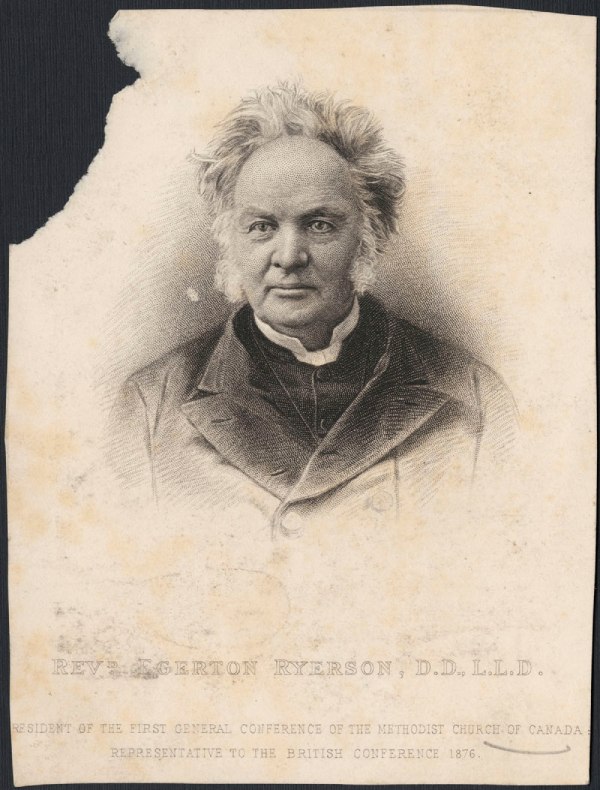Reverend Adolphus Egerton Ryerson National Historic Person (1803–1882)
The Historic Sites and Monuments Board of Canada is reviewing designated national historic persons, events and sites for their connection to the history and legacy of the residential school system. This review responds to the Truth and Reconciliation Commission’s Call to Action 79, which calls on the federal government to commemorate the history and legacy of residential schools.

© Library and Archives Canada / R9266-2858
Reverend Adolphus Egerton Ryerson was designated as a national historic person in 1934.
The Historic Sites and Monuments Board of Canada reviewed this designation in 2023. The following aspects of Ryerson’s contributions to Canadian history were declared of national historic significance.
Reasons for designation
Between 1844, when Ryerson became chief superintendent of education for Upper Canada, and his retirement in 1876, he played a major role in the establishment of Upper Canada and Ontario’s modern education system for children which later became the model throughout English Canada. After studying American and European models, he reformed the existing, inefficient system, including the establishment of a standard approach to schooling across the province, free and compulsory for elementary school children, with professional training for elementary and secondary school teachers. To advance post-secondary education in Ontario, he created Upper Canada Academy, which later became Victoria College in Toronto. As chief superintendent, he allowed for the formation of segregated schools for Black children, against the wishes of members of Black communities, which resulted in underfunded and unequal education for Black children.
In 1847, when the Province of Canada’s department of Indian Affairs asked for Ryerson’s views on the education of Indigenous children, he wrote a response that was later entitled Report of Dr Ryerson on Industrial Schools. His views focused on the importance of agricultural training, and he recommended voluntary residential manual labour institutes where First Nations children could learn to farm and would receive a basic education, which he believed would allow the children to participate in settler society. His recommendations were rooted in the 19th-century settler beliefs that Euro-Canadian culture and Christianity were superior to Indigenous cultures, traditions, and spiritual beliefs, and that these Euro-Canadian values should be imposed on Indigenous Peoples by means of assimilation and colonization. His report, published after his death, would be used to support the expansion of the Indian Residential School system, even though what he proposed in his brief was not the school system that Canada adopted in 1879, with devastating consequences for Indigenous Peoples in Canada.
A Methodist minister, he was the founder and first editor of the Methodist Christian Guardian in 1829. He furthered the cause of religious freedom for Methodists in Upper Canada in the early- to mid-19th century, contesting privileges held by the Church of England. He also produced popular histories of Loyalism and Canadian Methodism.
Review of designation
Reviews are undertaken on an ongoing basis to ensure that designations reflect current scholarship, shifts in historical understandings, and a range of voices, perspectives and experiences in Canadian society.
In 2023, this designation was reviewed due to colonial assumptions and an absence of a layer of history in the commemorative plaque text. The original text, approved in the 1970s, highlighted Ryerson’s career as a Methodist minister, and later chief superintendent of education for Upper Canada where he shaped the region's school systems. The original text did not reference his role in the formation of segregated schools for Black children. It also did not reference the Report of Dr Ryerson on Industrial Schools (1847), which was used after his death to support the expansion of the Indian Residential School system.
New reasons for designation were developed that include Ryerson's approach to the schooling of children in Black communities, as well as the 1847 report and its subsequent impact. No new plaque will be prepared as the limited text of a plaque does not allow for adequately communicating this complex history.
Source: Historic Sites and Monuments Board of Canada, Minutes, December 2021; June 2022.
The National Program of Historical Commemoration relies on the participation of Canadians in the identification of places, events and persons of national historic significance. Any member of the public can nominate a topic for consideration by the Historic Sites and Monuments Board of Canada.